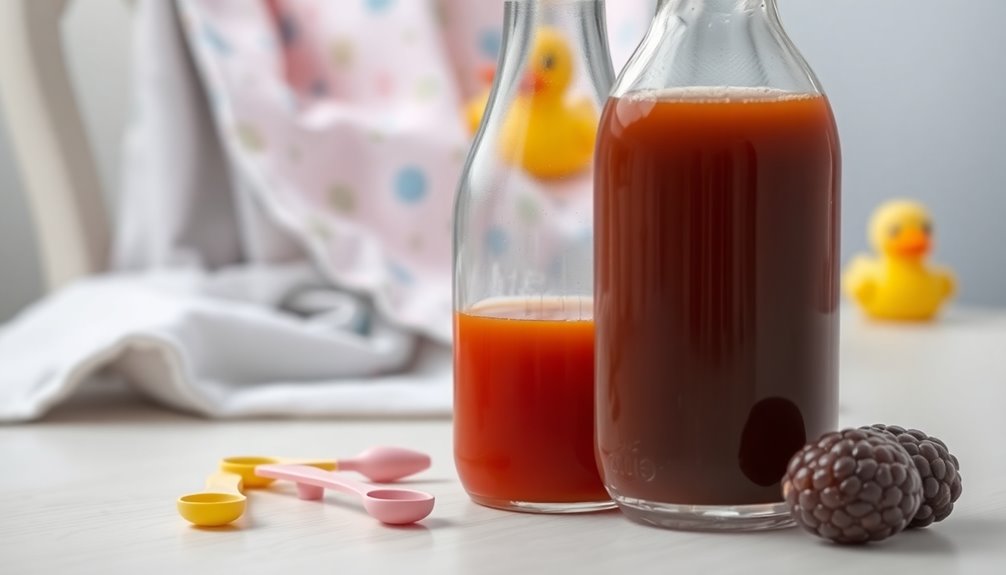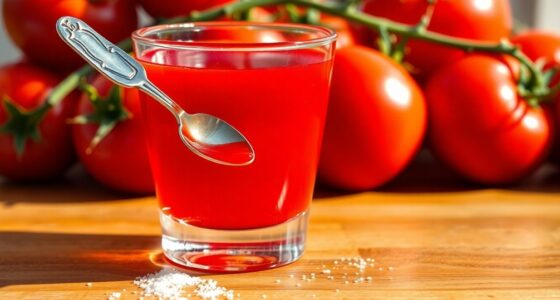When dealing with constipation for your 7-month-old, start with 1 ounce of prune juice mixed with 1 ounce of water. Offer this mixture 1 to 2 times a day, and don't exceed 4 ounces in 24 hours without talking to your pediatrician. Monitor how your baby reacts, adjusting the amount if needed. It's essential to maintain hydration and a balanced diet during this time. There's more to consider for a healthy approach.
Key Takeaways
- Start with 1 ounce of prune juice mixed with 1 ounce of water for a 7-month-old.
- Offer this mixture 1 to 2 times daily, monitoring the infant's reaction.
- Do not exceed 4 ounces of prune juice in a 24-hour period without pediatrician advice.
- Adjust the amount based on the baby's tolerance and any signs of discomfort.
- Always consult a pediatrician before introducing prune juice to ensure safety and appropriateness.

Introducing prune juice to your 7-month-old can be beneficial, especially if they're experiencing constipation. At this age, many infants are starting to explore solid foods, which can sometimes lead to digestive issues. Prune juice is a natural remedy that can help alleviate that discomfort, but it's essential to be mindful of the right amount and how to introduce it safely.
When you’re ready to introduce prune juice, the recommended dosage for your little one is 1 ounce of prune juice mixed with 1 ounce of water. This dilution is crucial for ensuring proper hydration and preventing any potential overwhelming effects on their delicate digestive system. You can give this mixture 1 to 2 times daily, but it’s important to note that you should never exceed 4 ounces in a 24-hour period without first consulting your pediatrician. They can provide guidance based on your infant’s specific health needs. As you monitor your child’s response to the prune juice, it’s essential to observe for any signs of discomfort or changes in bowel habits. If you’re ever unsure about how much prune juice is safe for your little one, don’t hesitate to reach out to your pediatrician for personalized advice. Remember, every child is different, and what works for one may not be appropriate for another, so keeping an open line of communication with your healthcare provider is key in managing your infant’s health.
As your baby starts to transition into solid foods, constipation can sometimes occur. This is where prune juice can come into play. It contains natural sorbitol, which acts as a gentle laxative and helps soften stool. However, always remember that moderation is key. While prune juice can be effective, excessive amounts might lead to stomach discomfort or diarrhea.
That's why monitoring your 7-month-old's reaction after introducing prune juice is crucial. Keep an eye out for any signs of discomfort, and adjust the amount accordingly. It's best to start with small amounts and gradually increase if needed, especially if your baby hasn't had juice before. Since every infant is different, what works for one mightn't work for another. So, being attentive to their reactions will help you determine the right course of action.
If you notice any adverse effects, it's always a good idea to revert to the previous amount and consult your pediatrician. Remember that introducing juice to your infant's diet shouldn't happen in isolation. It's essential to maintain a balanced approach as they adjust to solid foods. Ensure they're also getting plenty of water and other healthy foods to support their overall hydration and nutritional needs. This balanced approach will help your baby develop a healthy relationship with food and hydration.
Before you start giving your baby prune juice or any other type of juice, always chat with your pediatrician. They can provide tailored advice based on your baby's health history and ensure that it's a safe addition to their diet. With the right guidance and monitoring, prune juice can be an effective way to help your 7-month-old deal with constipation while ensuring they stay hydrated and healthy.
Frequently Asked Questions
Can You Give a 7 Month Old Prune Juice?
Yes, you can give your 7-month-old prune juice, but it's important to consult your pediatrician first.
Prune juice can help with digestion, but you should introduce it gradually. Start with a small amount, like 1 ounce, and consider diluting it with water to aid hydration.
Always monitor your baby for any reactions or discomfort, and remember that prune juice shouldn't replace breastfeeding or formula feeding.
How Do I Unconstipate My 7 Month Old?
If your 7-month-old is constipated, start by offering plenty of fluids, like water or diluted prune juice, to help soften the stool.
You can also introduce pureed fruits like pears or apples, which have natural laxative effects.
Gentle tummy massages and bicycle leg movements can stimulate digestion.
Always keep an eye on your baby for any discomfort, and if constipation continues, it's best to consult your pediatrician for tailored advice.
How Quickly Does Prune Juice Work?
Think of prune juice as a gentle rain shower for your baby's digestive garden.
It typically works within 12 to 24 hours to relieve constipation, depending on your little one's unique system. The high sorbitol content acts like a magnet, drawing water into the intestines, which helps soften stools.
Keep an eye on your baby for any discomfort, and if constipation persists, don't hesitate to consult your pediatrician for tailored advice.
Is 2 Cups of Prune Juice Too Much?
Yes, 2 cups of prune juice is way too much.
It's important to remember that excessive amounts can upset your digestive system and lead to discomfort or diarrhea.
You should start with small amounts and monitor how your body reacts.
If you're unsure about what's appropriate, it's best to consult with a healthcare professional.
They can provide guidance tailored to your needs and help you avoid any adverse effects.
Conclusion
In conclusion, when giving prune juice to your 7-month-old, start with just 1 to 2 ounces, mixing it with water if needed. Did you know that around 30% of babies experience constipation at some point? That's why prune juice can be a helpful remedy. Always consult your pediatrician before introducing new foods or drinks to ensure it's safe for your little one. Keeping their digestive health on track is essential for their growth and happiness!
Cindy thoroughly researches juicing trends, techniques, and recipes to provide readers with practical advice and inspiration. Her writing style is accessible, engaging, and designed to make complex concepts easy to understand. Cindy’s dedication to promoting the advantages of juicing shines through her work, empowering readers to make positive changes in their lives through the simple act of juicing.











